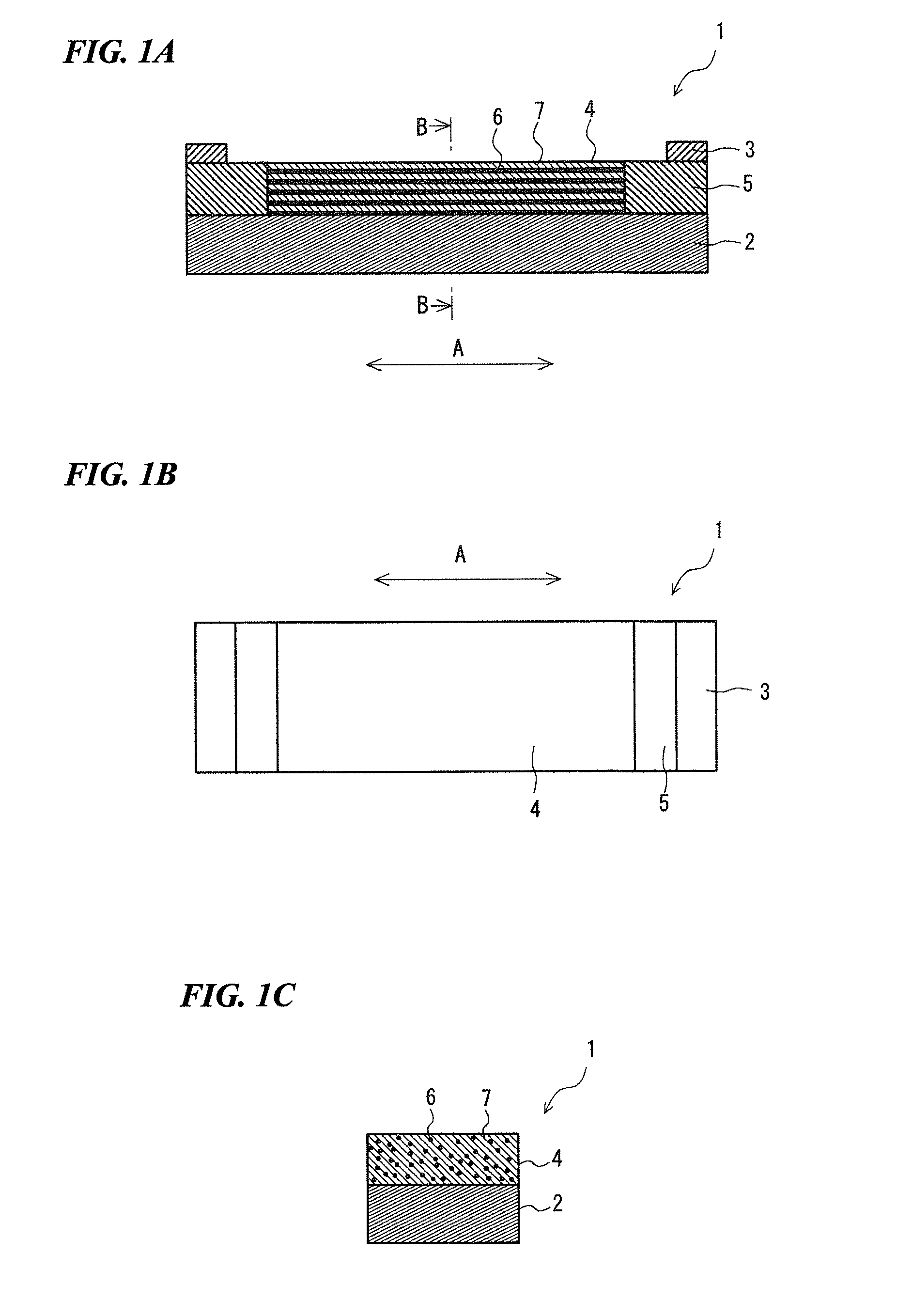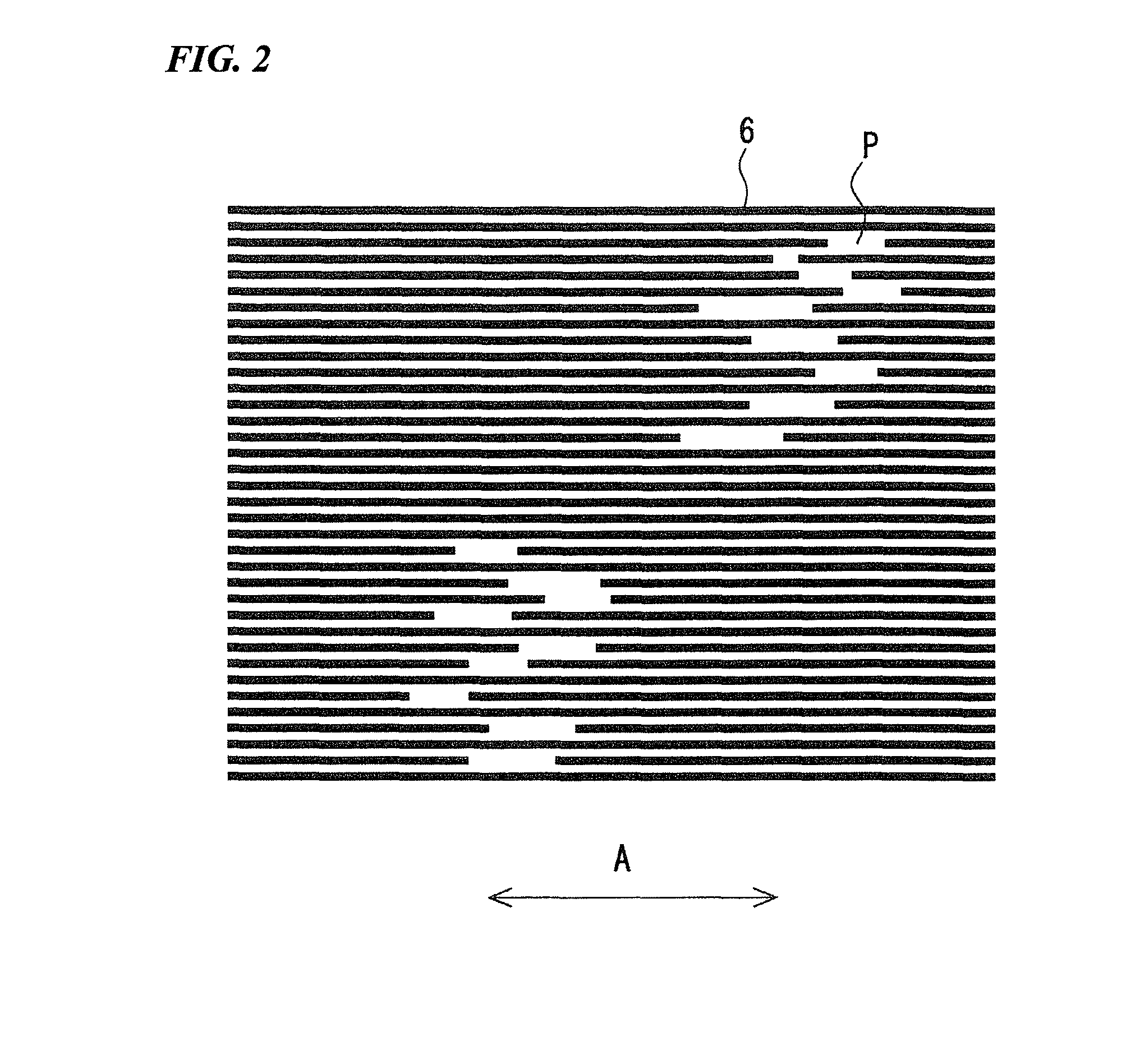Strain sensor
a sensor and cnt fiber technology, applied in the field of strain sensors, can solve the problems of difficult to obtain decrease in distance between cnt fibers, etc., and achieve the effect of inhibiting unexpected resistance changes, low compression in the thickness direction, and high linearity of resistance chang
- Summary
- Abstract
- Description
- Claims
- Application Information
AI Technical Summary
Benefits of technology
Problems solved by technology
Method used
Image
Examples
first embodiment
[0029]Referring to FIGS. 1A to 1C, a strain sensor 1 is provided with a substrate 2, a CNT film 4 that is provided on the surface side of this substrate 2 and that has a plurality of CNT fibers oriented in one direction, and a pair of electrodes 3 that are arranged at both ends of the CNT fibers in the orientation direction A.
(Substrate)
[0030]The substrate 2 is a plate-shaped body that has flexibility. The size of the substrate 2 is not particularly limited, and for example the thickness may be between 10 μm and 5 mm, the width between 1 mm and 5 cm, and the length between 1 cm and 20 cm.
[0031]The material of the substrate 2 is not particularly limited provided it has flexibility, with examples including synthetic resin, rubber, a nonwoven fabric, and a metal or metallic compound with a deformable shape or material. The substrate 2 should be an insulator or a material with a high resistance value, but in the case of using a material with a low resistance value such as metal, an insu...
second embodiment
[0085]A strain sensor 11 of FIG. 7 is mainly provided with the substrate 2, the pair of electrodes 3, the CNT film 4, and an assist layer 8 that is laminated on the back surface of the substrate 2. The substrate 2, the electrodes 3 and the CNT film 4 are the same as the strain sensor 1 shown in FIG. 1A to 1C, so they shall be given the same reference numerals, and their explanation shall be omitted.
[0086]The assist layer 8 is a material with a different Young's modulus than the substrate 2. By having this assist layer 8 be a member with a lower Young's modulus than the substrate 2, it is possible to enhance the following performance in the case of directly affixing the strain sensor 11 to skin or the like. Also, by making the assist layer 8 be a member with a higher Young's modulus than the substrate 2, it is possible to control the extension / contraction rate of the strain sensor 11 to prevent a delay in strain detection.
[0087]It is possible to suitably select the material of the as...
third embodiment
[0092]A strain sensor 21 of FIG. 8 is mainly provided with the substrate 2, the pair of electrodes 3, the CNT film 4, and an assist layer 9 that is laminated on the surface of the CNT film 4. The substrate 2, the electrodes 3 and the CNT film 4 are the same as the strain sensor 1 shown in FIGS. 1A to 1C, so they shall be given the same reference numerals, and their explanation shall be omitted. In addition, the assist layer 9 may be the same as the one in the strain sensor 11 of FIG. 11. Note that the assist layer 9 preferably also covers the conductive layer 5 as shown in FIG. 8.
[0093]Similarly to the strain sensor 11 of the second embodiment, it is possible by means of the assist layer 9 laminated on the surface of the CNT film 4 to improve the following performance of the strain sensor 21 with respect to movement of the body on which the strain sensor is affixed and also its detection sensitivity. Also, it is possible to more reliably prevent contamination of the CNT film 4 by fo...
PUM
| Property | Measurement | Unit |
|---|---|---|
| lengths | aaaaa | aaaaa |
| lengths | aaaaa | aaaaa |
| thickness | aaaaa | aaaaa |
Abstract
Description
Claims
Application Information
 Login to View More
Login to View More - R&D
- Intellectual Property
- Life Sciences
- Materials
- Tech Scout
- Unparalleled Data Quality
- Higher Quality Content
- 60% Fewer Hallucinations
Browse by: Latest US Patents, China's latest patents, Technical Efficacy Thesaurus, Application Domain, Technology Topic, Popular Technical Reports.
© 2025 PatSnap. All rights reserved.Legal|Privacy policy|Modern Slavery Act Transparency Statement|Sitemap|About US| Contact US: help@patsnap.com



